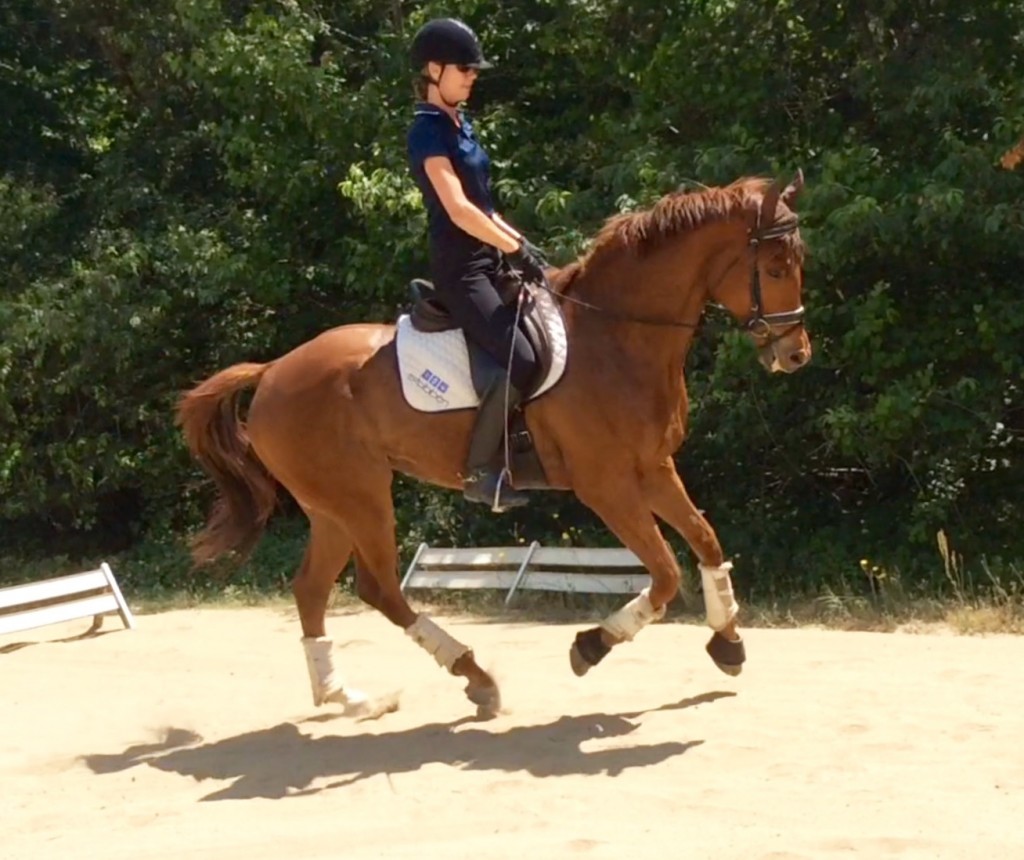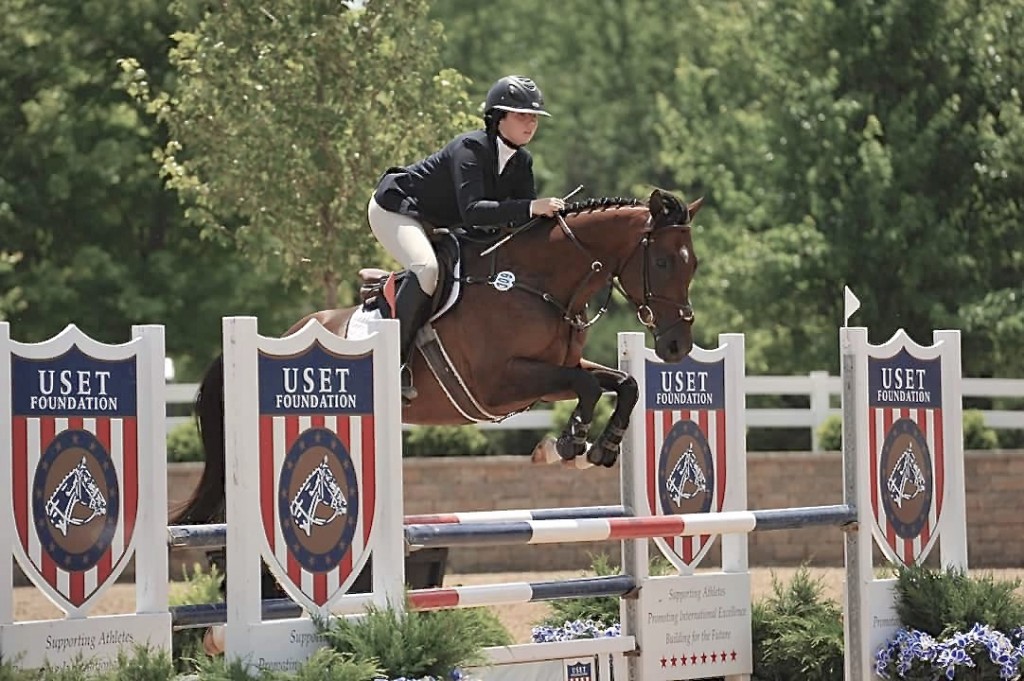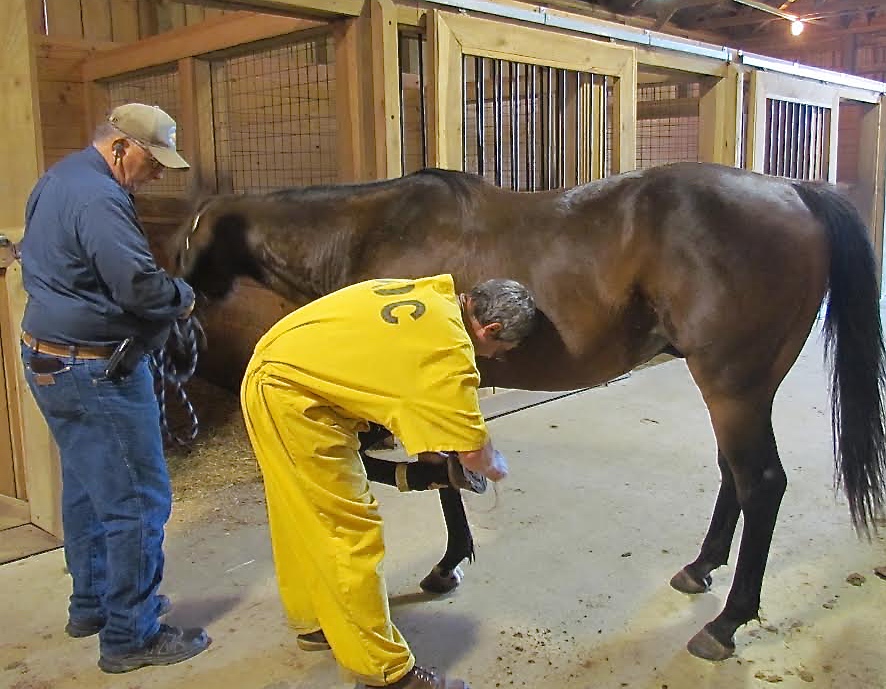
Celebrity Pam Stone trains Go Forrest Go for upper level dressage and blogs about it in Dressage Today.
A Thoroughbred born with legs so crooked he nearly died of complications has become the star in the family of an actress, comedian and writer whose life now centers around transforming the once wobbly chestnut gelding into an upper-level dressage mount.
Go Forrest Go, who suffered organ failure as a newborn when his terribly crooked legs failed to support him preventing him from standing to nurse, miraculously found support in a loving race family who shelled out a small fortune to save him.
Go Forrest Go
Barn: Forrest
Sire: Utopia (JPN)
Dam: Dangerous Beauty, by Meadowlake
Foal date: March 19, 2010And again today, the once misshapen T’bred has not only found a home with a celebrity and upper-level dressage rider, but with her help has become an ambassador for the Thoroughbred breed; enticing refined dressage riders competing on the most expensive Warmbloods.
As Forrest Gump had an uncanny talent for entering worlds that seemed beyond his grasp, so to, Go Forrest Go has entered the realm of celebrity; now starring in Dressage Today magazine blog Remember to Smile, penned by actress/comedian/writer Pam Stone, the former costar of 1990s TV series Coach.
Stone, an accomplished dressage rider who trained with members of past Olympic teams, adopted Go Forrest Go from Thoroughbred charity ReRun, Inc. in late 2013 with the intention of proving that upper-level dressage prospects can be found among the $1,000 Thoroughbreds of this world.

Forrest has always possessed a canter so uphill it looks like he’s climbing stairs. Stubben Saddlery sponsors the pair, who rides in the Genesis CL, which is specially designed for “shark finned” TBs.
It takes more than big money and a European Warmbloods to fill that role. It takes time to find the right horse, and a belief in the animal’s adaptability, she adds.
“If I had gone to Europe to buy a Warmblood for $30,000 and someone had walked Forrest out of the barn, I would have bought him on the spot,” says Stone. “He has a great walk, a huge shoulder, a huge strong hip and deep-set hocks, and this crazy uphill canter. It looks like he’s climbing stairs when he canters.”
Forrest caught Stone’s attention in 2013 after she decided to write a regular column in Dressage Today about one of the biggest setbacks faced by the average dressage rider: the prohibitive cost of a very competitive Dressage sport horse.
Noting that the upper levels of the sport are filled with expensive European Warmbloods who were bred for the sport, and that the average dressage rider is “not a middle-aged trust-fund baby” who can afford a $50,000 horse, Stone went to work looking for a Thoroughbred who could fit the bill.
In a year of scanning ads at myriad Thoroughbred charities and adoption agencies, she found three Thoroughbreds who had the natural uphill build and conformation she was looking for. And in October 2013 she found Forrest, a flashy chestnut with the perfect natural build and movement.

Forrest was far from perfect when he started training with Stone.
“I did a very reckless thing when I saw his video on Facebook, and I called Lisa Molloy at Re-Run Thoroughbred Adoption and said I’d take him,” she says, noting that she’d already visited the Virginia charity earlier in search of a prospect and felt confident in her decision.
He arrived two days before Christmas and was immediately given three months to relax and regrow his hoof angles to allow him to transition from racing to dressage. “I did not put a foot in a stirrup of that horse until July 2014,” Stone says. “I managed his progress very slowly and carefully.”
After a year of training, which began imperfectly with antics on the lunge line and under saddle, and concluded with amazing scope and reach of a well-balanced Thoroughbred, Stone has raised awareness about OTTBs in her Remember to Smile blog.
“When I first pitched the idea for this Cinderella story to the editors, my point was that all horse disciplines have become so expensive, and that the average dressage rider in America is a 42-year-old woman who is not a trust-fund baby. And all they’re trying to do is earn enough money to pay their board and take a few clinics when they can,” Stone says.

Stone costarred in popular TV series Coach in the late 80s and 90s.
“Few of these women will ever have the chance to buy a $50,000 Warmblood, and yet, we’re told in Pony Club that dressage can improve any horse. I wrote this blog to prove that I could find a $1,000 Thoroughbred who can be competitive. Because I don’t want people to get sucked in to this crap, that they need to go to Europe and buy an expensive Warmblood in order to be competitive.”
Cautioning that it took her a year to find Forrest, who possesses the ideal conformation—an uphill balance, big shoulder, high set neck—these horses are out there, says Stone.
“Forrest was born with terribly crooked legs,” she says. “He was owned by Aaron Racing of New York and his owners shipped him to the Reinbeck Clinic. It cost $1,000 a day to keep him in the ICU, and he spent the first six months of his life in leg braces.
But after he gained his strength and his legs evened out, Forrest would run with the other yearlings to the cheers of onlookers who would yell: “Go Forrest Go!”
And even a horse who begins life with the cards stacked against him can offer up a surprise. Just like the proverbial “box of chocolates”.









